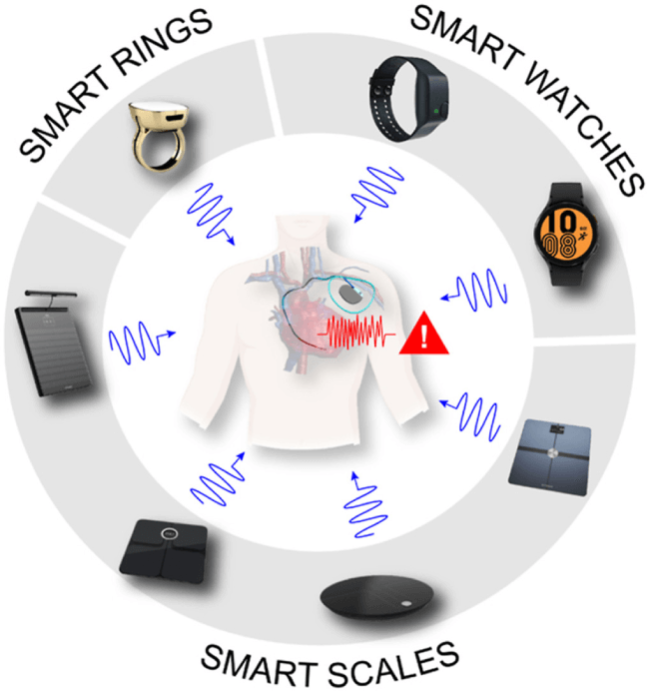Are Wearables Harmful to Cardiac Implants? Study Sheds Light
Insights | 07-03-2023 | By Robin Mitchell
Recently, researchers from the University of Utah have published a paper outlining how some wearable tech can be dangerous to those with implanted cardiac devices. The study found that wearable devices measuring bioimpedance can cause confusion in implanted cardiac devices, resulting in unexpected electric shocks and posing a danger to patients with pacemakers. The minute electric currents used by wearables can be substantial enough to cause a misfire or damage to the pacemaker due to EMI, EMC, and ESD. This danger can lead to arrhythmia, tachycardia, nerve shocks, and even heart attacks. What dangers have cardiac devices historically been vulnerable to, what did the researchers discover, and what does this mean for future wearable devices?
What dangers have cardiac devices historically been vulnerable to?
Thanks to the pacemaker, millions of people with heart defects have been able to live relatively normal lives, with the minor exception of needing to have the devices routinely checked, replaced every ten years or so, and having a small bump near their chest. By providing patients with control over arrhythmia, heart rates can be controlled to help eliminate the risk of heart attacks, thus eliminating extended periods of pain, as well as saving lives from heart attacks.
To provide this functionality, pacemakers are electronic devices implanted near the heart that monitor electrical activity, and if unusual activity is detected, electrical signals are sent to properly coordinate the heart muscles. Some pacemakers will only deliver electrical pulses when needed (i.e., missing beats), while others will continually provide a pulse.
However, due to the electrical nature of pacemakers, they are susceptible to local sources of EMI. As such, patients with pacemakers have historically been told to avoid sources of magnetic fields, such as MRIs, smartphones, and transformers. A magnetic field strong enough to induce a current in the internal electronics of the pacemaker can result in a glitch, which can either send a pulse when it shouldn’t, forget to send a pulse, or worse, damage the pacemaker altogether. Even induction hobs have been known to cause interference due to the intense magnetic fields generated by the hob coils.
Pacemakers are also susceptible to electrostatic discharge (ESD), which patients must avoid. While the static shock from a shopping trolley is unlikely to result in damage, any static shock across the chest could result in a misfire of the pacemaker or, worse, permanent damage.
Researchers discover cardiac devices vulnerable to wearable tech
While the wearable tech industry has started to show some modest growth, those involved with cardiac device research have begun to wonder if wearable tech has the ability to interfere with cardiac devices such as pacemakers. According to researchers from the University of Utah, it has been discovered that some wearable medical devices do indeed pose a risk to cardiac devices, and they have recommended that patients now avoid the use of wearable devices.
The issue lies with wearable medical devices that measure bioimpedance (the electrical resistance of the body), and this measurement is taken to determine skeletal density, muscle mass, and fat percentage. To measure bioimpedance, a small potential difference is applied to the body, which results in a minute current which is far too low to be noticed. By knowing the applied voltage and resulting current, the impedance of the body can be found, and the use of algorithms and specially pulsed currents can then be used to infer other information.
However, patients with cardiac devices who are exposed to bioimpedance measuring devices are at risk as the minute electric currents are substantial enough to cause confusion. As such, those with devices can be subjected to unexpected electric shocks from cardiac devices. While fatalities are unlikely to arise from such wearable devices, the resulting shocks can be painful and possibly enough to cause significant distraction when performing a dangerous task (such as driving).

Devices such as smart scales, watches, and rings that incorporate bioimpedance sensing technology could potentially disrupt the proper operation of implanted electronic cardiac devices.
What does this mean for the future of wearable medical devices?
For most, wearable devices that measure bioimpedance will provide no adverse effects whatsoever. In fact, these devices will help to provide valuable medical insight and, combined with AI, could help introduce better AI diagnostic systems.
However, for those with cardiac implants, such devices will likely be unusable, and the very real dangers posed by such devices will likely see new legislation introduced. Further warnings will have to be introduced into documentation and manuals, and doctors implanting cardiac devices will need to update patients on how wearables can cause dangers.
While engineers can change how bioimpedance sensors operate, possibly switching to high-frequency AC signals to try and circumvent sensitive pacemakers, such changes will likely take some time to implement across the industry.

